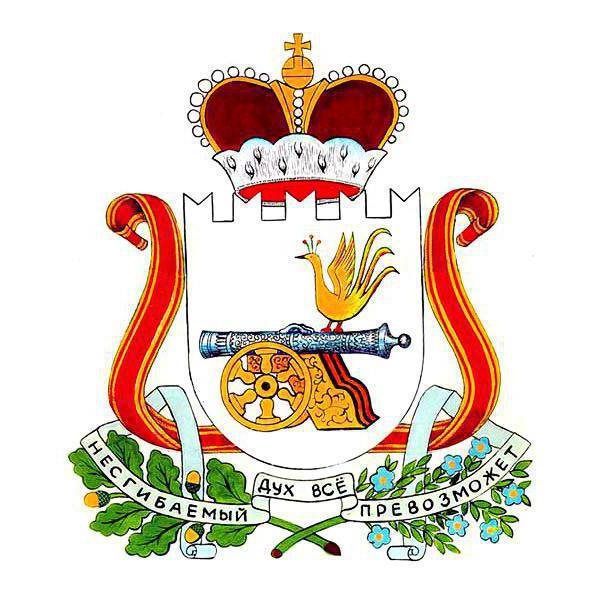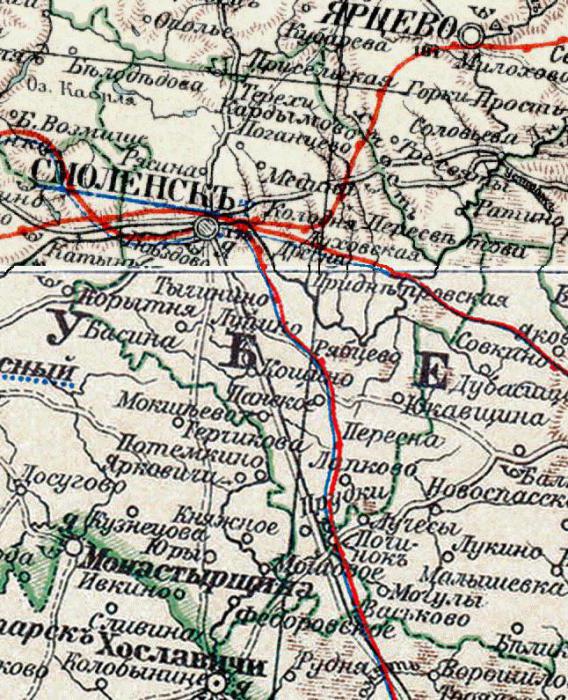Smolensk Province: counties and villages
The history of the appearance of the first provinces in the territoryTsarist Russia dates back to 1708. This type of territorial unit existed until 1929. In this way, the division of the territory of the state into smaller administrative units, like regional division, was accomplished.
The history of the appearance of Smolensk Province
During the creation of the eight provinces by Peter I in 1708the Smolensk Province was formed among others. The lands of this region were previously part of one territorial entity and were located in the European part of the country. Smolensk province existed until 1929, subsequently becoming an area in the course of the reformation of the territory of the Soviet Union. The main provincial town was Smolensk.

The specific location of the land of this territorial unit of Tsarist Russia ensured neighborhood and economic activity with most other provinces.
Bordered the province with the following lands:
• Tver province (north and north-east);
• Moscow and Kaluga (from the east);
• Orel (from the south to the east);
• Chernigov (from the south);
• Mogilev (from the west);
• Vitebsk and Pskov (from the north-west).
Reformation of land
The newly formed Smolensk province includedabout seventeen cities. The largest of them: Roslavl, Smolensk, White, Vyazma, Dorogobuzh. However, in 1713 the province was disbanded, its largest part went to the provincial part of the province of Riga.

Later, thirteen years later, it was partially restored. It consisted of five districts: Dorogobuzhsky, Belsky, Smolensk, Vyazemsky and Roslavl.
Somewhat later (in 1775) the province wasreformed into the Smolensk vicegerency. Due to territorial changes, seven new districts were included: Kaspliansky, Yelninsky, Krasninsky, Gzhatsky, Sychevsky, Porechsky, Ruposovsky. A few years later, Ruposovsky and Kasplinsky counties were transformed into Yukhnovsky and Dukhovshchina. And only in 1796 the governorship was reformatted again in the province.

Administrative territorial districts of Smolensk province:
• Yukhnovsky;
• Vyazemsky;
• Belsky;
• Gzhatsky;
• Dukhovshchina;
• Elninsky;
• Sychevsky;
• Dorogobuzhsky;
• Roslavl;
• Smolensky;
• Porecsky;
• Krasninskiy.
In the counties there were registered 241 volosts, 4130rural societies and about 14 thousand populated places. In addition, on the territory of the province there were eight suburbs and about 600 villages. The rest of the settlements were farms, small villages, farms. The length of the Smolensk province was 340 versts (one verst corresponds to the modern 1067 meters). Its territory was a little more than 49212 square miles.
Population
According to the census of 1897, the population of Smolenskthe province was slightly more than one and a half million inhabitants. In cities lived less than ten percent of the population, about 121 thousand of the townspeople. Before the abolition of serfdom in 1761, the number of serfs reached 70% of the total population.

Smolensk province had the highestan indicator of the unfree person among all the provinces of Tsarist Russia. On an average nobleman there were about 60 serfs. By the end of the 19th century there were 13 monasteries, 763 churches and one community in Smolensk province. The percentage of clergy was 0.6% of the total number of residents. Smolensk province as a separate territorial unit ceased to exist in 1929, and its lands were annexed to the Western region.
Industry and agriculture in the region
The villages of Smolensk province were famous for their skillfultanners and weavers. Local people mainly engaged in farming, cultivated cereals: rye, oats, buckwheat, wheat. Growing millet in a small volume was grown in Rostislavsky Uyezd. In Vyazemsky and Sychevsky districts, hemp and flax were cultivated. In the village of Tesovo, Sychevsky district, there was a flax-growing station. Weaving and paper mill were located in the village of Yartsevo Dukhovschinsky district. Match and leather production functioned in Rostislavsky uyezd. The manufacture of castings from crystal and wood processing was also widespread. In Belsky - tar and brickwork.
Smolensk province was famous for its gardens. Mostly they cultivated various varieties of apple, plum and pear. Apples were sold to Moscow. But Smolensk province was famous not only for agriculture.
Smolensk county
This region was the most densely populated, incomparison with other lands. The local residents conducted trade deals predominantly with the Lithuanians. Roslavl district mainly engaged in agricultural activities.

Only here grew buckwheat, barley and millet. For the first time, the Smolensk Agrarian Society was established to establish agriculture. There were warehouses of agricultural machines and implements. Very productive was the introduction of the plow to replace the plow. The guns made by local craftsmen were not inferior to the factory standard.
By 1880 in Smolensk province functioned954 factory and factory. In the next eighteen years the number of factories and plants increased by eight hundred. In particular, the dairies developed and improved, most of all in the eastern counties of the province.
Conclusion
Approximately about 1000 years ago it became clear thatfor the effective functioning of the state, division into administrative-territorial units is necessary. The first mentions date from the Xth century AD. Princess Olga divided the Novgorod lands into cemeteries. Later in the XV century, Ivan the Terrible conducted the division of the Novgorod territory into pyatines. At the beginning of the XVIII century, the concept of provinces and counties was introduced. They became the prototype of modern regions and regions.








